I have an excellent camera that I keep with me to use throughout the school day and at home. It's a Kodak Easy Share DX7590 that I bought a few years ago, so I'm not sure what the  equivalent is today. It has an automatic setting, but also allows for a range of manual options. It can also record short videos as .MOV files.
equivalent is today. It has an automatic setting, but also allows for a range of manual options. It can also record short videos as .MOV files.
 equivalent is today. It has an automatic setting, but also allows for a range of manual options. It can also record short videos as .MOV files.
equivalent is today. It has an automatic setting, but also allows for a range of manual options. It can also record short videos as .MOV files. When I first began using my camera I tended to use it mostly for special occasions. I took the photos, but often that was where they stayed - as a file on a computer. This week, I'd like to share some suggestions for how you can get photos working for you in the classroom. This post is by no means definitive so please share your ideas in the comments.
Build a sense of community with photos of students
Early in the year I take photographs of my students and get them up around the room often as labels. When students see photos of themselves in their classroom they feel a sense of belonging. These photos come in handy for other purposes throughout the year. With young students I have created "Who am I?" classbooks where students write a few clues about themselves at the top of the page and glue their photo with a flap covering it at the bottom of the page. These pages are then compiled into a book. The same photo can also be used for the covers of "Star of the Week" books, a goal wall and portfolio cover pages.
Take photographs of students as they work and learn
Sometimes you notice new things about your students as you take photographs of them as they work. Looking through a frame helps you to zone in on that particular child and block out other distractions. These photographs can help you to reflect on how students are progressing with their development. They also provide visible evidence that can be shared with parents during discussions.
I particularly like to use the video function of my camera to capture students when they work cooperatively in groups. It is interesting to review these later to see how each person participates in the task. I'm often impressed by the sort of language I hear my students using as they work together to solve problems.
These photos and videos can be shared with the school community through a newsletter or added to the class blog or school website.
Take photographs of students as they play and share fun times with friends
 I take lots of photos of the fun experiences we have throughout the year. These events often create positive emotions for students and the photos help students to relive these experiences. Collections of these photographs can be made into a Photo Story or Movie or viewed as a slideshow throughout the year. I received a digital photo frame for Christmas which I plan to use to play photos of the students throughout the day. (As a side note: Today I learnt how to pixelate faces with Gimp!)
I take lots of photos of the fun experiences we have throughout the year. These events often create positive emotions for students and the photos help students to relive these experiences. Collections of these photographs can be made into a Photo Story or Movie or viewed as a slideshow throughout the year. I received a digital photo frame for Christmas which I plan to use to play photos of the students throughout the day. (As a side note: Today I learnt how to pixelate faces with Gimp!)Take photographs of student work to discuss as part of a lesson
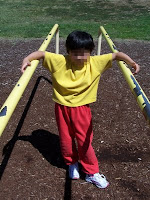
Photographing is a great way of capturing the hands-on experiences of students during a Maths lesson. I took my class out to the playground to explore the concept of position - under, over, between, through etc. The students posed for photos in a position on the playground. I then printed them out straight away and we made labels to go with the images eg. "Hannah is between the bars".
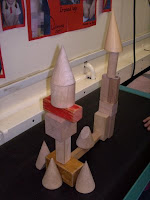 Another time students worked in groups to make buildings out of 3D shape blocks. I took photos of the buildings and then put the images up on the interactive whiteboard for discussion. Students named the different 3D shapes that had been used. This allowed for everyone to have a good view of the buildings without the issues of students crowding the building or blocking someone's view.
Another time students worked in groups to make buildings out of 3D shape blocks. I took photos of the buildings and then put the images up on the interactive whiteboard for discussion. Students named the different 3D shapes that had been used. This allowed for everyone to have a good view of the buildings without the issues of students crowding the building or blocking someone's view.As a spelling lesson, students worked in groups of three to make words  with a common rime. As soon as a group had made a word they brought it to me and had their photo taken. They then went off to make another word. We then used the digital images to review the words and select spelling words for the week. (Faces are cropped her for privacy but were present in class activities).
with a common rime. As soon as a group had made a word they brought it to me and had their photo taken. They then went off to make another word. We then used the digital images to review the words and select spelling words for the week. (Faces are cropped her for privacy but were present in class activities).
 with a common rime. As soon as a group had made a word they brought it to me and had their photo taken. They then went off to make another word. We then used the digital images to review the words and select spelling words for the week. (Faces are cropped her for privacy but were present in class activities).
with a common rime. As soon as a group had made a word they brought it to me and had their photo taken. They then went off to make another word. We then used the digital images to review the words and select spelling words for the week. (Faces are cropped her for privacy but were present in class activities).Take photographs during excursions, special school events and cooking sessions

Photographs help to aid memory when students sit down to write. If you want students to write a recount of a special event photographs are a great visual aid to assist with ordering the events and including details. When writing a procedure they provide additional visual information which may be difficult to explain in words. These recounts could be made into a PowerPoint slideshow, Photostory or movie and shared with the school community online.
Capture moments of interest to share in class
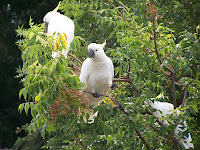
If you have a camera with you when you're out and about (even as an application on your phone) you can be on the lookout for images that will interest your students. I have captured rainbows, dragonflies, cockatoos and hot air balloons to discuss with students in class. This is a great way of bringing science into the classroom without a lot of fuss. It also provides the opportunity to show how science relates to real world experiences.
Take photos for students to use in their artwork
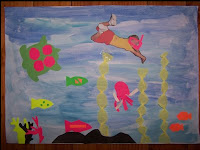 Students can create multi-media artworks including photographs of themselves as the subject. I have seen classes where a photograph was taken and cut along the line of symmetry. Students then drew in the other side of their face.
Students can create multi-media artworks including photographs of themselves as the subject. I have seen classes where a photograph was taken and cut along the line of symmetry. Students then drew in the other side of their face.Recently my students were creating an underwater scene of The Great Barrier Reef. One student asked if we could include a photograph of them pretending to swim as part of the collage. Students lay on the floor and posed for photos which were easily printed and included in the artwork.
Take photos of students with their parents at the school
When we have a learning journey at our school I keep out the camera to take photos of students with their parents as they demonstrate their learning. You can capture some really lovely moments during this time. These photos also remind students about their parents' interest in their learning.
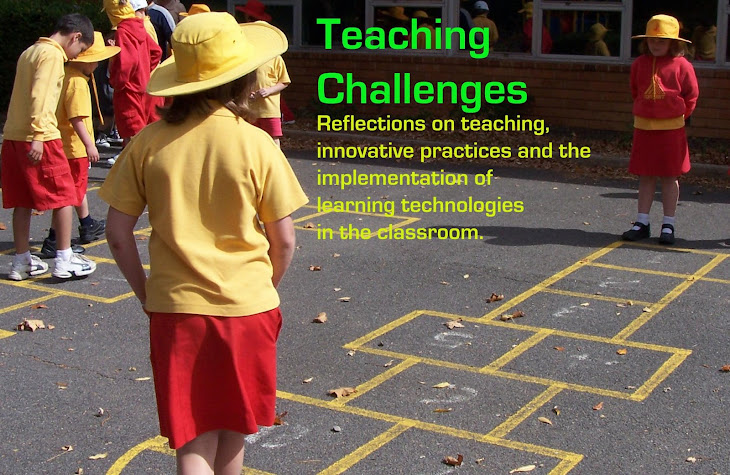





Penny,
ReplyDeleteMany thanks for the great ideas of how to use a digital camera every day in the classroom! I plan to bookmark this posting and let my tech and art teachers know about your creative ideas.
-Alix Peshette
http://edtechgoldrush.blogspot.com
http://del.icio.us/artfully/
Great tips Penny
ReplyDeleteI use many of them but seeing them explained here has given me new ideas. Thanks for that. I have a picture/name match-up worksheet as a literacy activity. You remind me that I can use these small images in their artwork as well. We could even create our own individual books of friends in action.
The pictures go a long way in explaining what we are doing in class and one of the most valuable things is the way photos open up lines of communication between parent and child. Since I include photos in my almost weekly newsletter, and post it online, the parent can interact with their child in front of the computer, asking questions with the child as the expert.
I too leave my camera on my desk to take photos during lessons but you have given me more ideas. Thanks. One way my students used the camera last year was to create 5-frame stories which we uploaded to the flickr group that @heymilly started. http://www.flickr.com/groups/tellyourstorykids/
ReplyDeleteI really cool thing that you could do to make your classroom more "homey" with all of the pictures you take of your students is to invest in a digital picture frame. Then, you can have photos of your students continuously appearing on the frame. I found a cool one by a company called CEIVA. If you get the adapter, you can send pictures over Wi-Fi. Very cool. http://www.ceiva.com/?utm_source=bc
ReplyDeleteI also take photos in my classroom as well as photos for the school website. I would be lost without my camera. Have you ever used the photographs to create some type of multimedia presentation? For example, your students could use the pictures taken from a special event or field trip to create an iMovie or a podcast in which they narrate the script as the pictures appear on the screen. My students create these types of projects all the time and they love doing them!
ReplyDelete